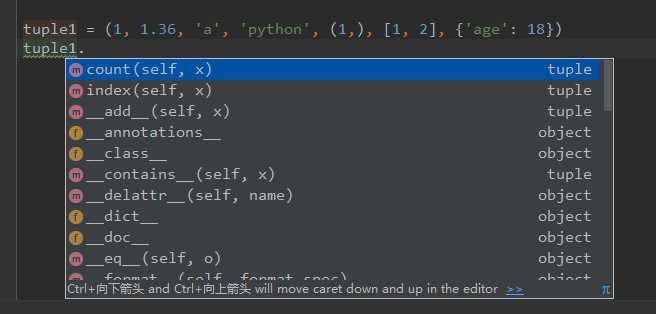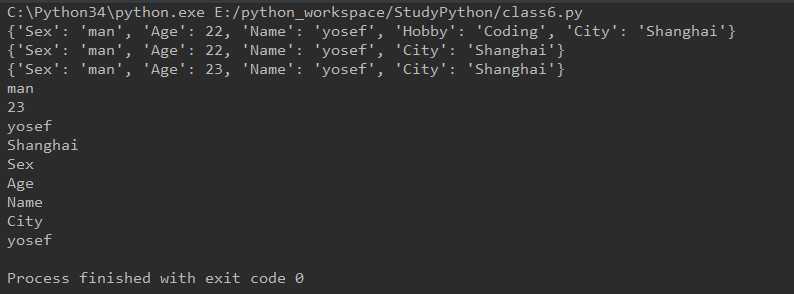标签:字符 div 查看 变量类型 man 通过 rev dex 语句
在博主学习列表,元组以及字典的时候,经常搞混这三者。因为他们都是用括号表示的。分别是[],(),{}.
[1,‘abc‘,1.26,[1,2,3],(1,2,3),{‘age:18‘}]
列表中的元素可以是整型,浮点型,字符串,也可以是元组,列表,字典。
列表中的元素是有序的,而且元素可以更改,包括增删改。列表类似于Java之中的数组。
列表的常用方法:append,extend,remove,insert,pop,sort,reverse。
1 #!/usr/bin/python3 2 # -*- coding: utf-8 -*- 3 # @Time :2018/11/23 13:54 4 # @Author :yosef 5 # @Email :wurz529@foxmail.com 6 # @File: :class4.py 7 # @Software :PyCharm Community Edition 8 9 list1 = [1, 1.36, ‘a‘, ‘python‘, (1,), [1, 2], {‘age‘: 18}] 10 11 # print(list1) 12 # for i in list1: 13 # print(i) 14 # list1.append("5") # append方法只能在列表的末尾添加一个元素 15 16 # 增 append extend insert 17 list1.append("10") # append方法只能在列表的末尾添加一个元素 18 print(list1) 19 20 list1.extend([1, 2]) # extend方法可以连接两个列表list 21 print(list1) 22 23 list1.insert(1, 0.36) # insert相比append, insert可以插入具体位置,append只能在末尾。 24 list1.insert(13,"这是11") # 当索引位置大于list原本长度,相当于在末尾增加元素 25 # print(len(list1)) 26 print(list1) 27 28 # 删 1.python的del 2.list的remove 3. list的pop 29 del list1[0] # del方法可以通过索引直接删除list之中的某个元素 30 print(list1) 31 32 list1.extend([0.36, 0.36]) 33 list1.remove(0.36) # remove方法是通过传入的值删除list中相匹配的第一个元素 34 print(list1) 35 36 list1.pop(0) # pop方法也是通过索引来删除list中元素,对比del方法,一个是Python自带,一个是list自带 37 print(list1) 38 39 # 改 直接通过list索引来修改相应位置的值 40 list1[0] = ‘b‘ 41 print(list1) 42 43 # 查 类似于字符串的查 44 print(list1) # 打印list所有元素 45 print(list1[0:1]) # 打印list的第一个元素 46 print(list1[2:5]) # 打印list的第3-5个元素 47 print(list1[-1]) # 打印list的最后一个元素
这是结果:

元组有序,且不可修改。
先看这张图:

我们从编译器中可以看到,元组只有2个方法,一个是计数另一个是看索引,并不支持增删改查。
1 #!/usr/bin/python3 2 # -*- coding: utf-8 -*- 3 # @Time :2018/11/23 16:43 4 # @Author :yosef 5 # @Email :wurz529@foxmail.com 6 # @File: :class5.py 7 # @Software :PyCharm Community Edition 8 9 tuple1 = (1, 1.36, ‘a‘, ‘python‘, (1,), [1, 2], {‘age‘: 18}) 10 print(tuple1.count(1)) # 参数计数 11 print(tuple1.index(1.36)) # 元素索引位置
元组内部元素不可修改,但是内部元素的列表,字典可以修改其内部元素。注意,当元组只有一个元素时,要在元素后加上",",否则会当成原本的变量类型处理。
1 tuple2=(1,) 2 tuple3=(1) 3 print(tuple2,tuple3)
结果:
tuple2是元组,tuple3是整型3.
首先对于字典,我们要知道它与列表元组不同的是,字典是无序的,可以增加修改删除。字典的对应关系是key: value.
1 #!/usr/bin/python3 2 # -*- coding: utf-8 -*- 3 # @Time :2018/11/23 17:11 4 # @Author :yosef 5 # @Email :wurz529@foxmail.com 6 # @File: :class6.py 7 # @Software :PyCharm Community Edition 8 9 dict1 = {"Name": "yosef", 10 "Sex": "man", 11 "Age": 22, 12 "City": "Shanghai"} 13 14 # 增加 15 dict1["Hobby"] = "Coding" # 不需要调用方法,直接用dict[new_key] = value 可以新增新的key:value 16 print(dict1) 17 18 # 删除 19 dict1.pop("Hobby") # 调用dict的pop方法,可以删除不需要的key:value。传入的参数是key 20 print(dict1) 21 22 # 修改 23 dict1["Age"] = 23 # 这里语句与新增一样,如果原本有key,则覆盖原本的,即修改,反之新增一个key:value 24 print(dict1) 25 26 # 查看 27 for value in dict1.values(): # 查看字典的所有value 28 print(value) 29 30 for key in dict1.keys(): # 查看字典的所有key 31 print(key) 32 33 print(dict1["Name"]) # 通过key查看value
结果:

标签:字符 div 查看 变量类型 man 通过 rev dex 语句
原文地址:https://www.cnblogs.com/wlyhy/p/10008838.html